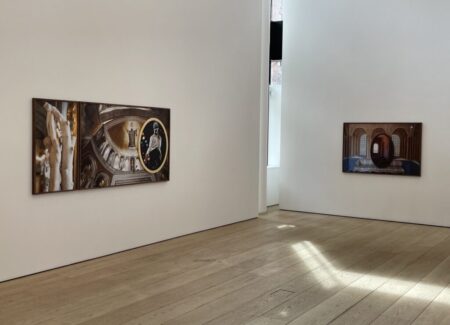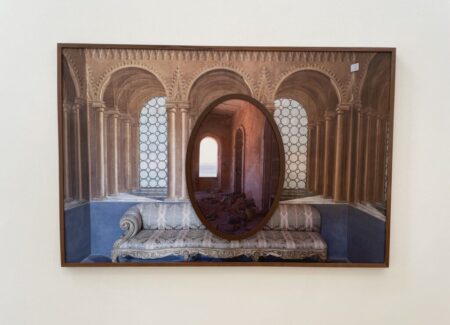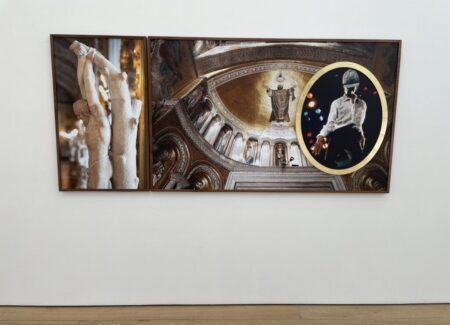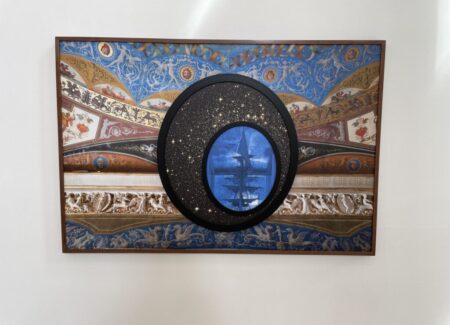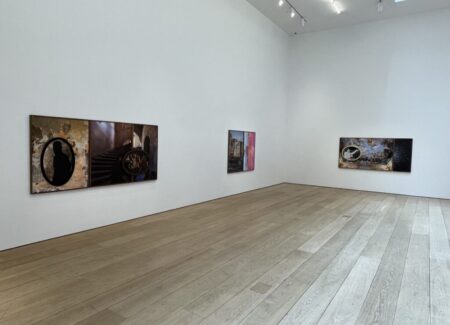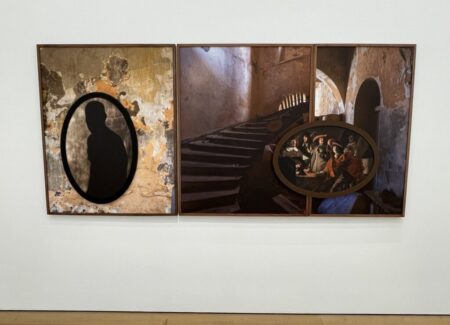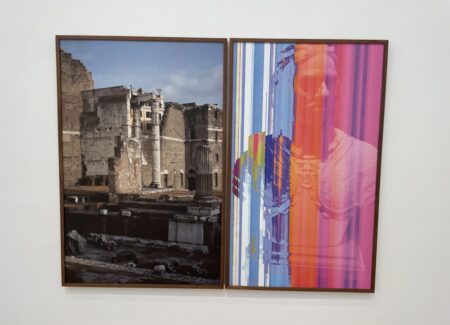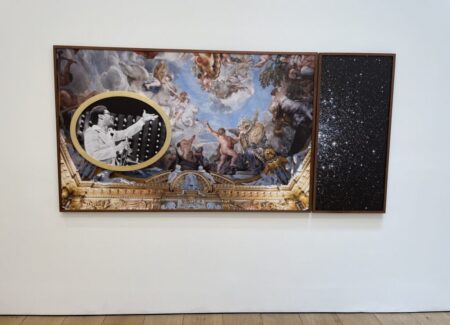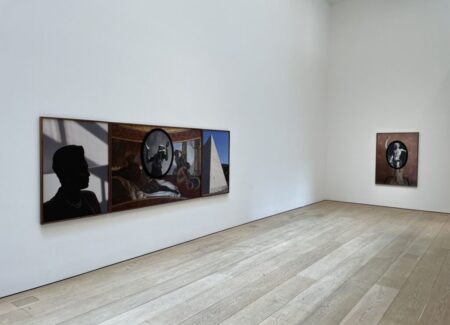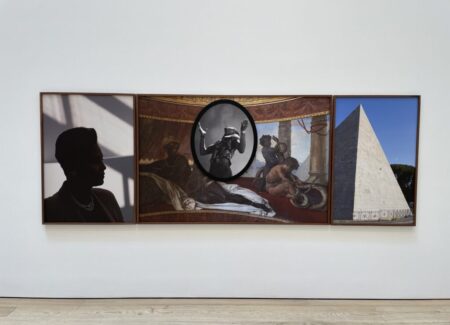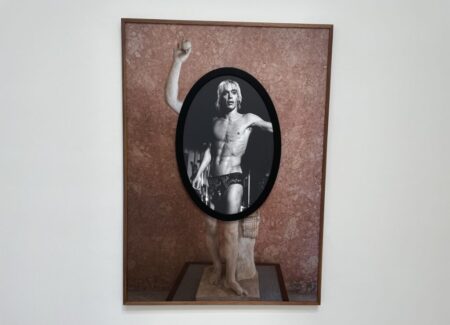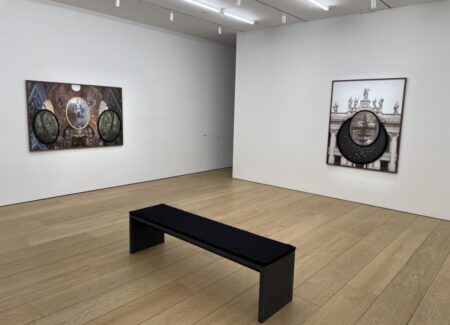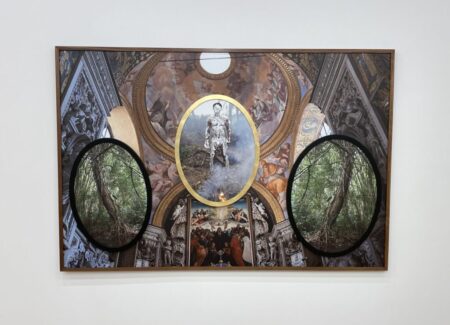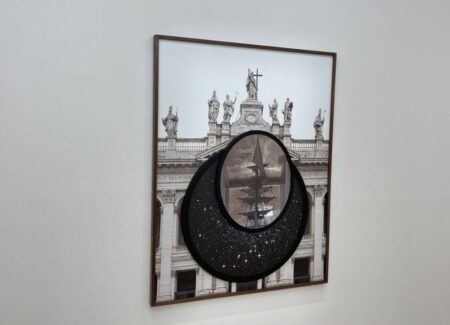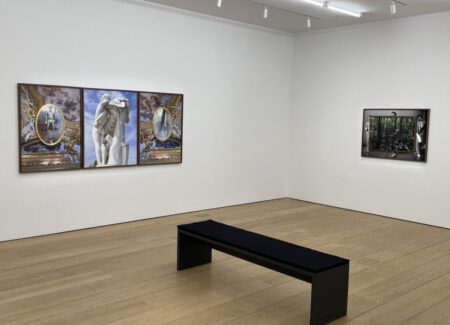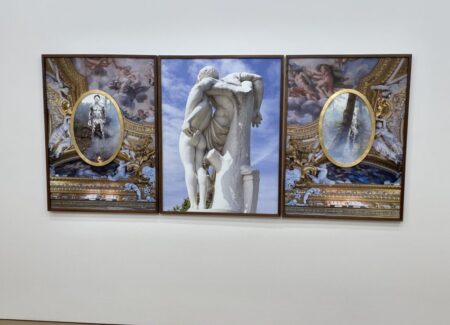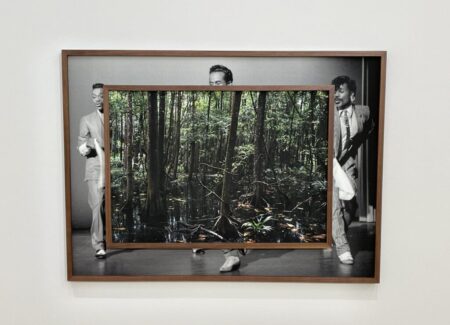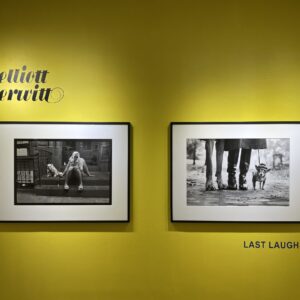JTF (just the facts): A total of 12 photographic works, installed in the two gallery spaces on the main floor and in a smaller room on the lower level. (Installation shots below.)
The following works are included in the show:
- 2 sets of 5 UV pigment prints on Dibond, artist’s frames, 2024, sized roughly 44x100x2, 49x106x2 inches, unique
- 2 sets of 4 UV pigment prints on Dibond, artist’s frames, 2024, sized roughly 45x67x2, 50x142x2 inches, unique
- 4 sets of 3 UV pigment prints on Dibond, artist’s frames, 2024, sized roughly 41x61x3, 44x97x2, 48x97x2, 60x48x3 inches, unique
- 4 sets of 2 UV pigment prints on Dibond, artist’s frames, 2024, sized roughly 33x47x2, 40x60x2, 61x43x2, 53x67x2 inches, unique
Comments/Context: When an artist forms a new gallery representation relationship, there is a natural tendency to want to introduce the artist’s work to the gallery’s specific audience via a broad sampler show that surveys his or her career. But this approach can often wander into something approaching predictable greatest hits (or whatever’s still available), thereby missing out on an opportunity to use the scarce slot in the gallery’s exhibition calendar to make a more definitive statement or to present an artist’s newest ideas.
With a handsome recent survey exhibit held just this past year at The 8th Floor (reviewed here), Todd Gray didn’t need to kick off his connection with Lehmann Maupin with a sampler or a succinct introduction, and has instead smartly jumped feet first into the present, with a show of a dozen fresh works all made in 2024. Gray spent time on a fellowship at the American Academy in Rome in 2023, and most of his new works use images of Roman Catholic cathedrals and ancient statuary from Rome (and elsewhere it Italy) as their visual foundation or starting point.
In the past handful of years, Gray’s artistic career has noticeably accelerated, and during that time, his unique brand of photocollage has settled down into what we might call a mature style. What’s special about his approach is the way he constructs his assemblages, by physically layering framed full images on top of one another, like stacks built out from the flat plane of the wall. This piling of framed imagery functions differently that other fragmentary photocollage or photomontage works in that it introduces visual interruptions, obstructions, and combinations that go beyond the usual flat collage techniques of side-by-side juxtaposition and visual echoing. When Gray places one or more framed photographs on top of another to create his works, he creates layers of dialogue, disruption, commentary, and time shifting that offer powerful opportunities for upending and recalibrating what we see.
Thematically, Gray has consistently probed the nuances of colonialism and the African diaspora, in particular leveraging images of ornate European architecture and formal gardens as representations of imperial power dynamics, which he has then interrupted with pictures of slave ports and landscapes in Ghana and along the West African coast, Black musicians and celebrities, and the cosmos as seen from the Hubble telescope. Here, he turns his attention to Roman Catholic imagery, in the form of photographs of painted ceilings, frescoes, religious icons, decorative statuary, and architectural details like cathedral vaults and windowed alcoves, which he then liberally disrupts and re-interprets.
Gestural echoes enliven two of the larger works, pairing famous 20th century musicians with ancient religious figures. In one, a smiling Al Green raises his hand almost to match the raised hand of a god-like muscular figure on a ceiling fresco, like a call and response greeting, with the heavenly sky extended by a nearby view of a dense starscape. In the other, Michael Jackson struts though some dance steps under the outstretched arms of a saintly figure above, with both adorned in sparkly costumes and golden auras; Jackson’s artistry is then flanked by a slave figure tied to a tree in an ancient statue, giving his performance an alternate historical context. In both works, famous black men become stand-ins for revered religious icons, creating associated frictions and cultural commentaries, with time and space seemingly collapsed into singular moments.
A similar kind of time compression takes place in two other works featuring images a French slave ship. In both works, the model ship from the House of Slaves museum in Gorée island, in Senegal (alternately seen in enveloping blue and murky grey) floats on a sea of stars, ultimately grounded by an intricately patterned ceiling (from the Villa Torlonia, once the residence of Benito Mussolini) and an ornate architectural facade decorated with columns and statuary. Other works feature images of worn stairways and shadowy window niches at the slave port, and the combined effect of the assemblages is quietly haunting, with the echoes of slavery embedded in the economics of built grandeur and drifting across the vastness of time.
Another set of works pushes harder on the spiritual aspect of the Catholic architecture, upending its decorative extravagance with images of African forests and a shaman figure (perhaps Gray himself) covered in white foam. The curves of ornate arches and ceiling vaults are echoed by sinuously bending tree trunks, and the nude shaman figure stands with the same kind of authority embodied by saints and apostles. In another work, Gray twists these associations further, by interrupting a group of Black entertainers with a view of the same forest, making parallels of dance-like movement. Together, the varied juxtapositions in these works create rich dialogues between disparate but linked religious practices, tying them together with invisible strands of connective tissue.
Gray’s works are most persuasive when he finds balance in unstable opposition, where deliberate harmonies of visual aesthetics are undermined by conceptual dissonances and mindset shifts. Often his works operate on multiple levels of interpretation simultaneously, but even a relatively simple work like an image of Iggy Pop interrupting an image a Roman statue, replacing one form of aspirational celebrity with another to create an uneasy hybrid, can deliver his point or commentary with literal incisiveness. Juggling four or five images is a much trickier feat, but when those pictures come into momentary alignment (both aesthetically and conceptually), that complex synchronicity packs a surprisingly memorable punch.
Collector’s POV: The works in this show are priced between $40000 and $115000, based on size. Gray’s works have little consistent secondary market history at this point, so gallery retail likely remains the best option for those collectors interested in following up.
